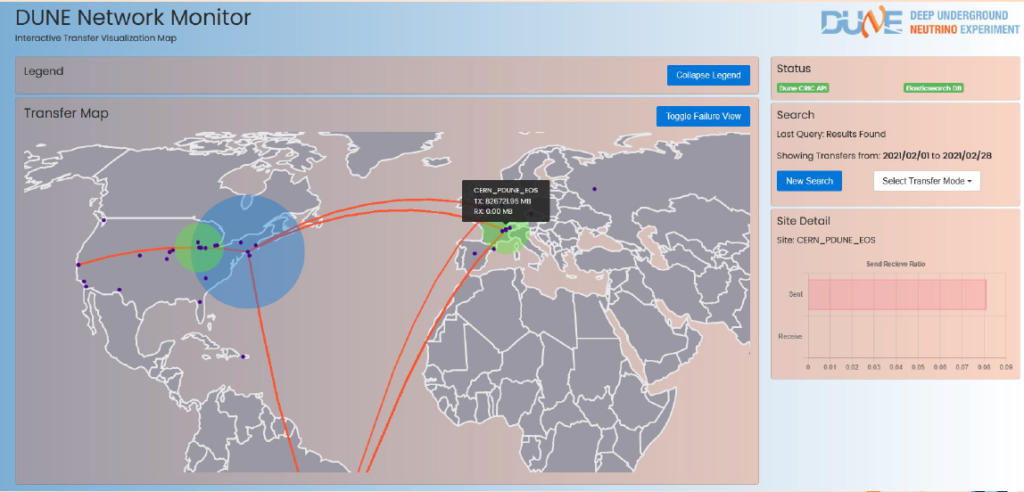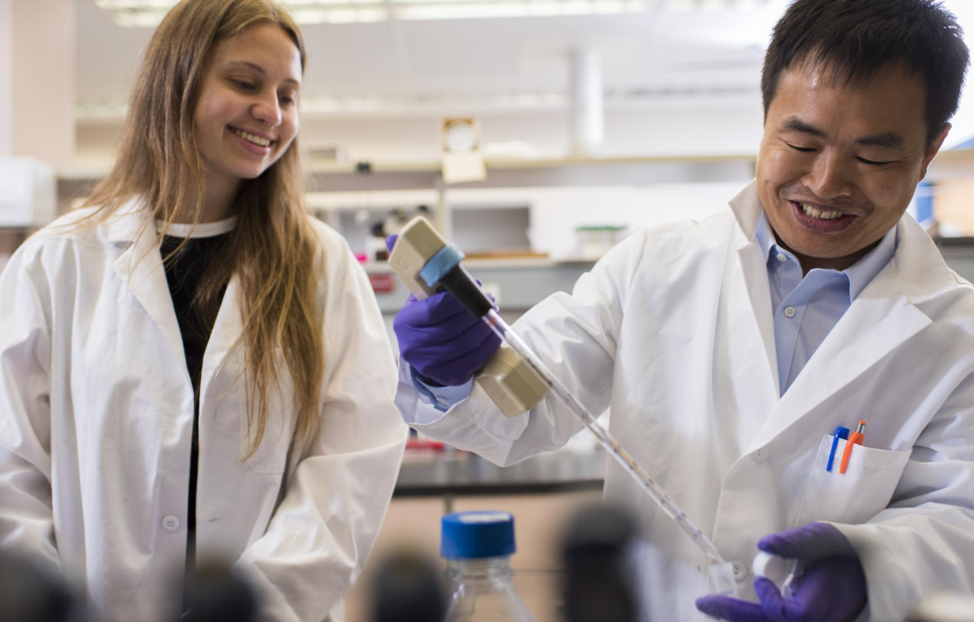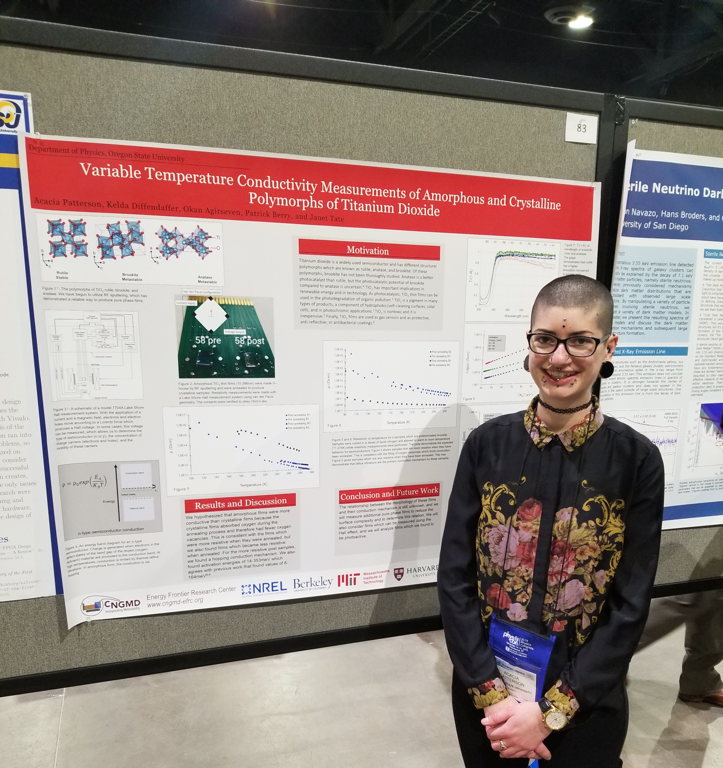Reposted from impact.science.oregonstate.edu
Looking back on his gut decision in high school to major in physics after taking a class in it, graduating senior Abe Teklu remains somewhat mystified. “I guess I was just really confident,” he laughs.
Abe grew up around numbers and changing locations, moving from Ethiopia to Arizona at age six when his father got an engineering job at Intel, and then moving to Colorado before his family settled outside of Portland when he was 12.
His family is mathematically inclined. His mom is an accountant and his dad, who not so secretly yearned to be a mathematician, is an engineer who reads calculus books and earned a master’s degree in fluid dynamics. This home field advantage explains some of Abe’s youthful confidence (he “loved math” even as a child) but since then Abe has carried the ball all on his own.
At Oregon State as an Honors physics student, Abe has remained confident – at least most of the time – as well as comfortable with numbers and shifting contexts. He has had three research internships. The first was the summer after his sophomore year when he had a paid internship at Northwestern University’s Center for Interdisciplinary Exploration and Research in Astrophysics (CIERA) in Evanston, Illinois, in a rather niche but fascinating area of speculative research called astrobiology. There Abe analyzed mathematical models of theoretical predator-prey systems not limited to planet Earth.
The summer before his junior year, Abe headed down to San Diego for another paid internship, this time at the U.S. Department of Energy’s DIII-D National Fusion Facility. The facilty consists of a tokamak, a magnetic fusion device which Abe describes as “a big metal donut spinning plasma to get fusion energy.” Abe used magnetohydrodynamics (MHD) theory to model plasma confinement, with the goal of understanding which conditions better spread heat flux in the divertor region.
In his third research experience, Abe spent more than two years working in physics department head Heidi Schellman’s Particle Physics Research Group, analyzing neutrino-antineutrino data as part of the MINERvA, a major international research effort exploring matter-antimatter differences in neutrino physics. This involved aiming a beam of neutrinos from Illinois to South Dakota. Specifically, Abe worked on the recoil energies recorded when the rare neutrino-antineutrino reactions hit parallel strips of the scintillator, each of which is connected to a photomultiplier tube that determines how much energy is deposited in a strip.
Abe’s research experiences beyond the classroom gave him many advantages. For one, the DIII-D fusion internship formed the basis for his senior thesis. He also learned valuable lessons about the nature of scientific work.
“Unlike class, where there is always an answer, research is open-ended. It was difficult for me at first, but I came to appreciate that even if you don’t solve a problem, you are contributing to a much larger research effort with scientists around the world that will one day lead to a solution.”
Throughout his four years at OSU, community and relationships were key to Abe’s success, a sentiment reflected in his two top pieces of advice for new students.
“Have as much fun as you can freshman year. Talk toeveryone. You will have the most free time this year and so it’s a great time to meet new people and make friends. It gets harder after that.”
As an Honors College freshman, Abe enjoyed meeting friends in his dorm, Cauthorne, and also hung out in West so often that he was mistaken as a resident. He was and is “surprised by the amount of really smart people here. So many amazing people – and it’s so cool now to see all of my friends going off to exciting new destinations next year, from MIT to Brown to AI research!”
His second piece of advice?
“Talk to professors. Go to office hours. Not just to talk about academics, but just to talk about life. It’s helped me out a lot.”
Some of his favorite professors to hang out with are physicists
Corinne Monogue, who he calls a “great teacher and person to talk to about anything at all” and
Heidi Schellman. Abe suggests another good reason to talk with professors: It’s a “great way to start research sooner.”
To wit, when Abe visited to Schellman during her office hours, she began describing her research and Abe just jumped in and asked if he could help.
“That day she gave me a key to her lab and I started doing research!” Two years later, Abe still has a coveted seat in Schellman’s Lab and is currently mentoring a new student to take his place after graduation.
Despite his success at OSU, Abe has faced his share of rejection and challenging times. Before joining the Schellman Lab, he was turned down as a freshman for research positions. The fall of his senior year was a really difficult time. After an intense summer working at the fusion facility DIII-D in San Diego, he returned to campus for a nonstop term which on top of his usual demanding coursework included studying for the Physics GRE, applying to graduate schools, writing his senior thesis and dealing with the inevitable “personal stuff.”
“I was overwhelmed and my confidence was shaken. Was I good enough? I had imposter syndrome. The only thing that got me out of it,” Abe reflects, “was just to endure. I just kept going step by step, every single day. I had to keep going and I did and it finally got better.”
It certainly did. Abe was accepted into the physics Ph.D. program at Stonybrook University in Long Island, New York, remarking with great enthusiasm upon the fact that there are no less than “60-70 physics researchers there!” Not wasting any time, he will jumpstart his graduate research this summer at CERN in Geneva, Switzerland, working on a yet-to-be-defined research project with his graduate advisor.
“All of my professors were great,” he said. The junior-year Paradigms in Physics series in particular, which was redesigned to include interactive pedagogies and real-world applications to better reflect how professional physicists think, was a real game-changer for Abe.
“[The junior-year Paradigms in Physics] was hard, but it was great and everyone in the class bonded together. We came out feeling that we could do anything!”
Abe’s gratitude extends to the many scholarships he received that helped cement his choice to go to Oregon State. He received the university’s four-year Academic Achievement award as well as a freshman year Honors College scholarship, a Kenneth S. Krane Scholarship in Physics and a David B. Nicodemus Scholarship in Physics.














